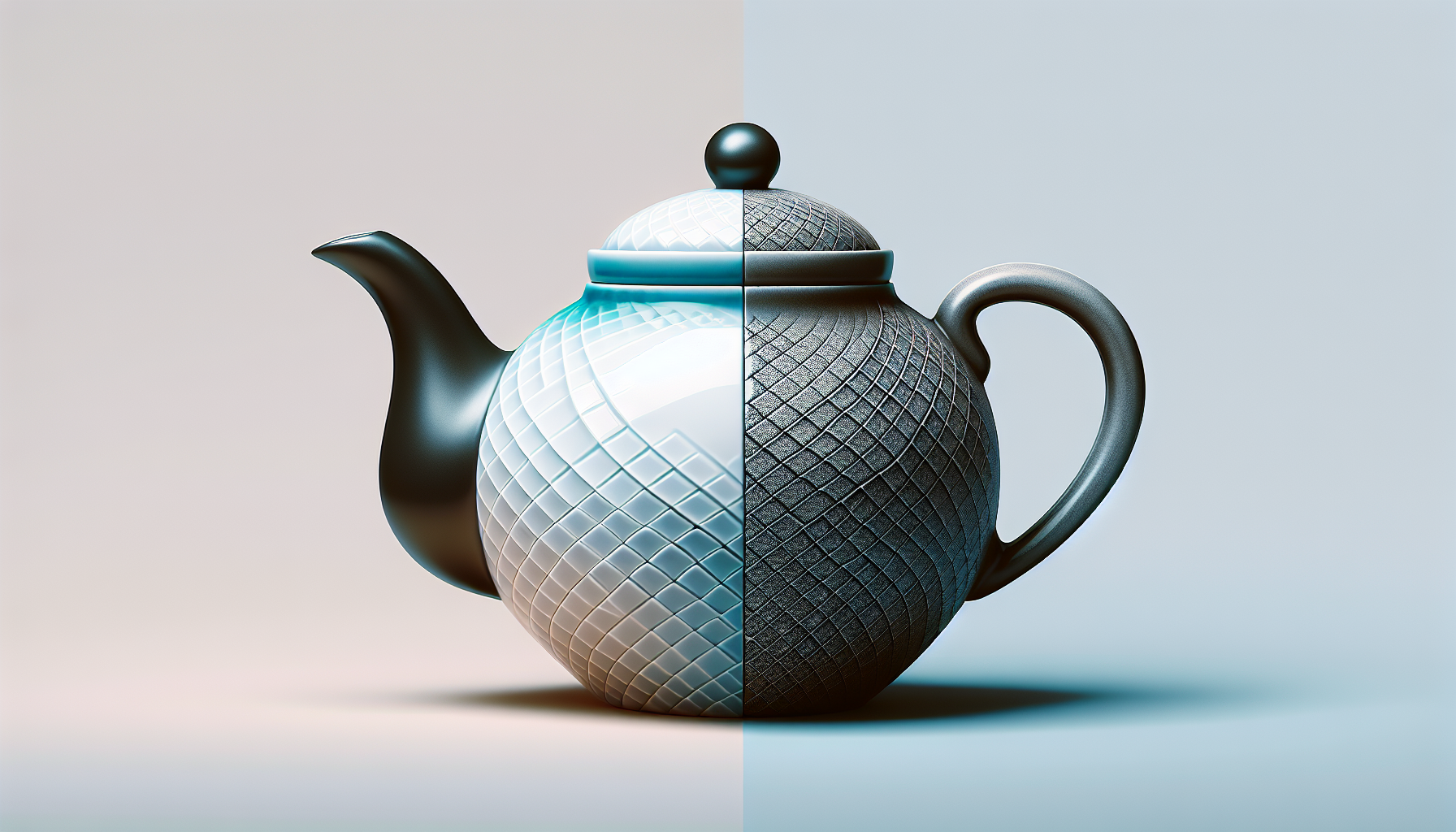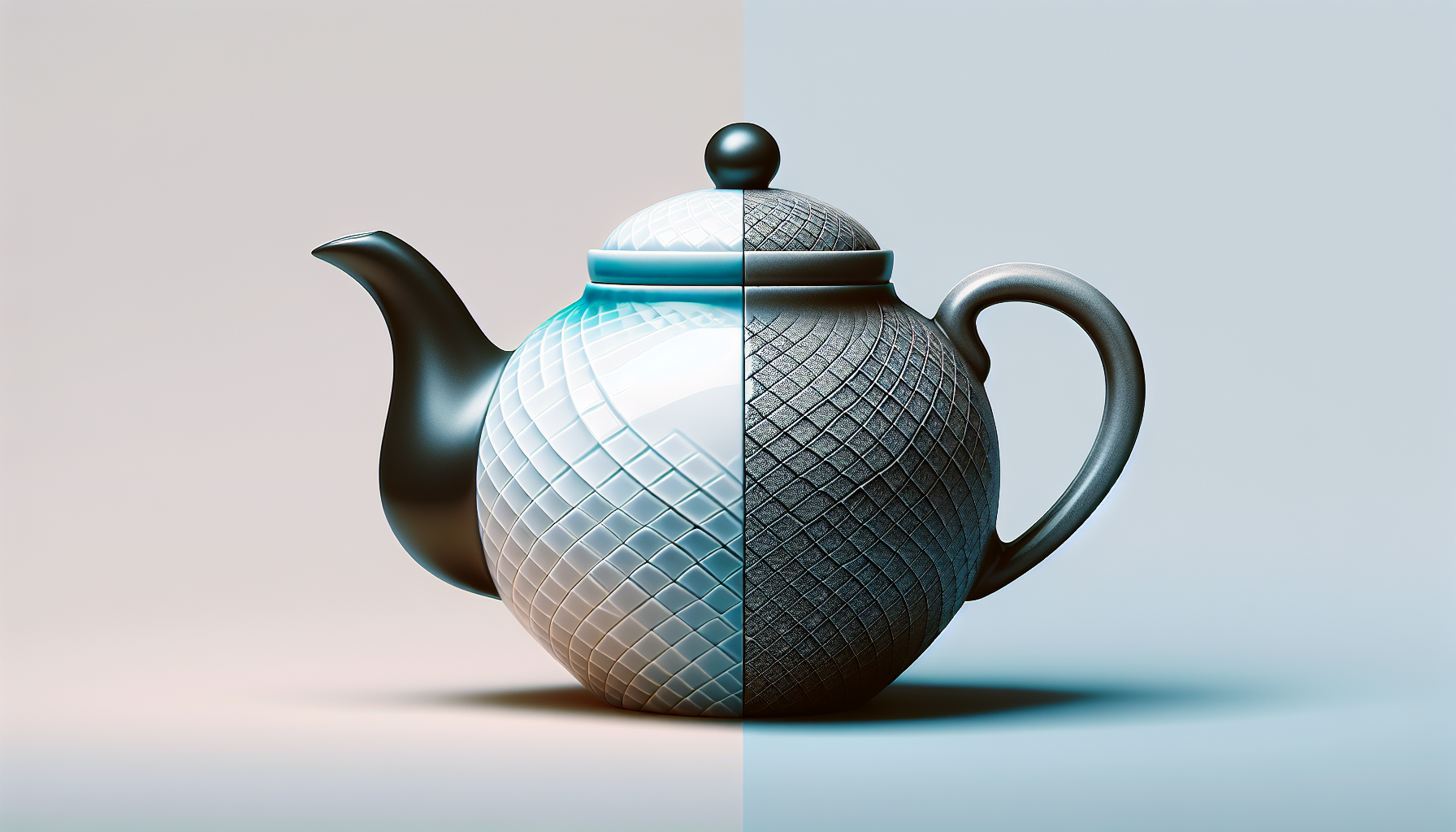Have you ever wondered which material is better for a teapot, porcelain or ceramic? Whether you’re a tea enthusiast or simply enjoy a warm cuppa every now and then, it’s fascinating to explore the differences between these two popular materials. Both porcelain and ceramic have their own unique qualities and characteristics, but determining which one is superior for a teapot requires a closer look at their respective advantages and drawbacks. So, let’s dive in and explore the world of teapots, porcelain, and ceramic to uncover the best choice for your brewing needs.

CHECK OUT TEA KETTLES AND TEAPOTS ON AMAZON
Durability
Porcelain
Porcelain is known for its durability and strength. It is made from a fine pottery clay that is fired at high temperatures, resulting in a hard and sturdy material. Porcelain teapots are less likely to chip or crack, making them a great choice for everyday use. The dense composition of porcelain also helps it to retain heat, allowing your tea to stay hot for longer periods of time.
Ceramic
Ceramic teapots also offer good durability, but they may not be as strong as porcelain. Ceramic teapots are typically made from various types of clay and fired at lower temperatures. While they can still withstand normal daily use, ceramic teapots may be more prone to chipping or cracking compared to porcelain. However, with proper care and handling, ceramic teapots can still provide years of reliable service.
Heat Retention
Porcelain
Porcelain teapots are known for their excellent heat retention properties. The dense nature of porcelain helps to trap and hold the heat inside the teapot, allowing your tea to stay warm for a longer duration. This means that you can enjoy multiple cups of hot tea without having to reheat the teapot frequently. If you prefer to savor your tea slowly or often engage in longer tea sessions, a porcelain teapot would be an ideal choice.
Ceramic
Ceramic teapots also offer decent heat retention capabilities, although they may not retain heat as effectively as porcelain teapots. The lower firing temperatures of ceramic may result in slightly quicker heat loss compared to porcelain. However, for shorter tea sessions or those who prefer to drink their tea relatively quickly, a ceramic teapot can still be a suitable option. It is worth noting that the type of clay used and the thickness of the ceramic material can also impact heat retention.
Heat Distribution
Porcelain
Porcelain teapots generally have good heat distribution properties. The uniform density of porcelain allows heat to be evenly distributed throughout the teapot, ensuring that your tea brews evenly. This can help to extract the full flavor and aroma from your tea leaves, providing a satisfying and consistent brew every time. Whether you are steeping delicate white teas or bold black teas, a porcelain teapot can help achieve optimal results.
Ceramic
Ceramic teapots also offer reasonable heat distribution, although they may not distribute heat as evenly as porcelain teapots. The heat conductivity of ceramic can vary depending on the specific type of clay used. Some ceramic teapots may have hotspots or areas that heat up faster than others, which can lead to uneven brewing. However, with a bit of attention and properly adjusting steeping times, you can still achieve a flavorful cup of tea with a ceramic teapot.
Resistance to Stains and Odors
Porcelain
Porcelain teapots are highly resistant to stains and odors. The smooth and non-porous surface of porcelain makes it difficult for tea stains to adhere, allowing for easier cleaning and maintenance. Additionally, porcelain does not absorb odors, ensuring that your teapot will not retain any unwanted smells from previous brews. This makes porcelain teapots an excellent choice for brewing a variety of teas without worrying about flavor contamination.
Ceramic
Ceramic teapots may be slightly more prone to staining compared to porcelain due to their porous nature. The porous surface of ceramic can absorb tea residues over time, which may result in discoloration or faint stains. However, with proper care and regular cleaning, the staining can be minimized. As for odors, ceramic teapots can also retain traces of previous brews if not cleaned thoroughly, so it is important to ensure proper maintenance and drying after each use.
Cleaning and Maintenance
Porcelain
Porcelain teapots are relatively easy to clean and maintain. Their non-porous surface makes it simple to rinse off tea residues and stains. For regular cleaning, warm water and a mild dishwashing detergent are usually sufficient. It is recommended to avoid using abrasive cleaning tools or harsh chemicals that can damage the porcelain finish. Additionally, allowing the teapot to thoroughly dry before storing can help prevent the growth of mold or mildew.
Ceramic
Ceramic teapots require similar cleaning and maintenance procedures as porcelain teapots. However, due to their porous nature, ceramic teapots may require a bit more effort to remove stubborn tea stains. Using a soft sponge or cloth and a gentle scrubbing motion can help to minimize any potential damage to the ceramic surface. It is also important to ensure that the teapot is completely dry after cleaning to prevent mold or mildew from developing.
Aesthetics
Porcelain
Porcelain teapots are often favored for their elegant and refined appearance. The smooth and glossy finish of porcelain gives it a sleek and luxurious look. Porcelain teapots come in a wide range of colors and designs, making it easy to find one that matches your personal taste and complements your tea set or tableware. Whether you prefer a classic, minimalist design or a more elaborate and decorative style, there is a porcelain teapot that can enhance the aesthetic appeal of your tea experience.
Ceramic
Ceramic teapots offer a charming and rustic aesthetic. The varied textures and earthy tones of ceramic enhance a cozy and warm atmosphere. From hand-painted designs to handcrafted patterns, ceramic teapots showcase the artisanal craftsmanship that goes into creating each piece. The versatility of ceramic allows for a wide range of styles and designs, making it possible to find a teapot that suits your individual preferences and adds a touch of personality to your tea rituals.
Price Range
Porcelain
Porcelain teapots tend to be more expensive compared to ceramic teapots. The production process, including the high firing temperatures and the use of high-quality clay, contributes to the higher price tag. However, the durability and exquisite aesthetics of porcelain teapots often justify the investment for tea enthusiasts who value longevity and a touch of elegance in their tea brewing experience.
Ceramic
Ceramic teapots are generally more affordable than porcelain teapots. The lower firing temperatures and the availability of different types of clay contribute to the lower production costs. While ceramic teapots may lack some of the premium features and durability of porcelain teapots, they still offer a great value for those looking for a budget-friendly option without compromising on functionality and style.
Typical Uses
Porcelain
Porcelain teapots are a popular choice for formal tea ceremonies and special occasions. Their elegant and refined appearance makes them well-suited for hosting guests or displaying on a tea tray. Porcelain teapots are often used for brewing delicate and high-quality teas, such as white tea or green tea, where precise temperature control and optimal steeping times are essential for extracting the tea’s delicate flavors.
Ceramic
Ceramic teapots are versatile and can be used for various tea-drinking occasions. Their rustic charm and durability make them suitable for both casual everyday use and more laid-back tea gatherings. Ceramic teapots are often chosen for brewing a wide range of teas, including black tea, oolong tea, and herbal infusions. Whether you are enjoying a morning cup of tea alone or hosting a cozy tea party with friends, a ceramic teapot can adapt to different settings.
CHECK OUT TEA KETTLES AND TEAPOTS ON AMAZON
Availability
Porcelain
Porcelain teapots are widely available in specialized tea shops, kitchenware stores, and online retailers. Their popularity in tea cultures around the world ensures a consistent supply of porcelain teapots in various sizes, styles, and price ranges. With a bit of searching, you can find a porcelain teapot that suits your preferences and budget.
Ceramic
Ceramic teapots are also readily available in a variety of places, including specialty tea shops, home decor stores, and online marketplaces. The wide range of ceramic teapots available allows you to explore different designs, colors, and sizes, ensuring that you can find a ceramic teapot that matches your taste and meets your tea brewing needs.
Personal Preference
Factors to Consider
When choosing between porcelain and ceramic teapots, there are several factors to consider:
- Durability: If you prioritize durability and resistance to damage, porcelain teapots may be the better choice.
- Heat Retention: If you prefer your tea to stay warm for a longer duration, porcelain teapots excel in heat retention.
- Heat Distribution: For optimal flavor extraction, porcelain teapots provide more even heat distribution.
- Stain and Odor Resistance: If cleanliness and easy maintenance are important to you, porcelain teapots are highly resistant to stains and odors.
- Aesthetics: Consider your personal style and the overall aesthetic you want to achieve when selecting between the elegant look of porcelain or the rustic charm of ceramic.
- Price: Determine your budget and weigh the investment of a porcelain teapot against the affordability of a ceramic teapot.
Factors that May Influence Choice
Several factors may influence your choice between porcelain and ceramic teapots:
- Tea Preference: Consider the types of teas you regularly drink and whether certain teas may benefit from the specific features of porcelain or ceramic teapots.
- Occasion: Determine the frequency and setting in which you plan to use the teapot. Formal occasions may lean towards porcelain, while everyday use may favor ceramic.
- Level of Care: Assess your willingness and ability to provide the necessary cleaning and maintenance for the teapot of your choice.
- Personal Taste: Ultimately, your personal style and aesthetic preferences will play a significant role in selecting the teapot that resonates with you.
In conclusion, both porcelain and ceramic teapots have their unique advantages and considerations. Porcelain teapots offer exceptional durability, heat retention, heat distribution, and resistance to stains and odors. They also provide an elegant and refined aesthetic, although they may come with a higher price tag. On the other hand, ceramic teapots are more affordable and offer a charming rustic appeal. While they may not have the same level of durability and stain resistance as porcelain, ceramic teapots still provide satisfactory heat retention and distribution. Consider factors such as your tea preferences, occasion, level of care, and personal taste to determine whether a porcelain or ceramic teapot is the better choice for your teatime rituals.

